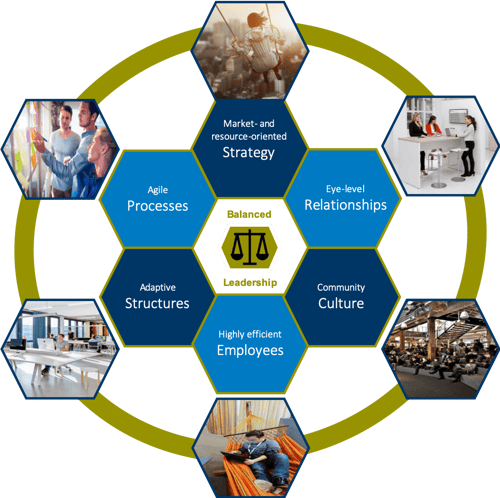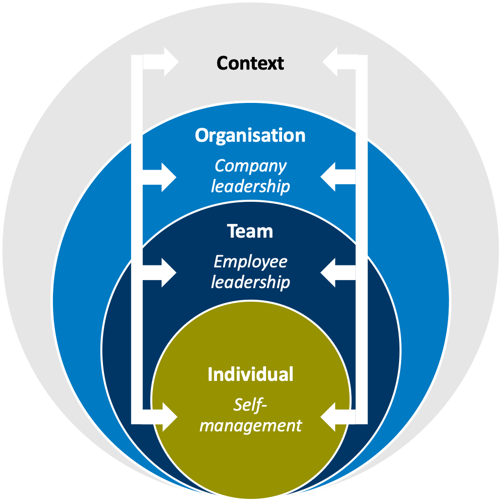New working environments (3) - room and leadership 4.0
In the series "New Work" we deal with the requirements of the working environment, so that "New Work" can succeed. The central point in the Healthy Organization is balanced leadership. Entrepreneurial thinking, committed, creative, happy and healthy employees are ultimately the greatest competitive advantage a company can create.
The brain researcher Gerald Hüther emphasizes that motivation always arises when the quality of interaction and the quality of the environment are right. The working environment, the space, is a decisive success factor for our work.
In the third part of the series on "New Work", we deal with the construct of leadership, its influence and its effect on the meaningful use of space.

Figure 1: The Healthy Organisation and quality of the environment
Good leadership has always been a challenge. Digitalization has added new requirements to the VUCA world: unconditional transparency, maximum flexibility, meaningful networking and high participation. To lead means to support people, to lead themselves and to develop others or as Prof. Götz Werner says:
"Leadership today is only legitimate if it aims at the self-management of the people entrusted to its care.
More and more people are knowledge workers, which means that their task is no longer simply to carry out defined tasks, but to be able to solve new problems with their knowledge and experience. Creativity and intuition are especially important now in post-digitisation. But which spatial concepts promote these developments and which areas are affected?
In our concept of balanced leadership, leadership takes place on three levels. Those responsible lead themselves, assume responsibility for others in the team and also lead the overall organisation. 
Figure 2: Leadership in the context of Healthy Organization
Implementing these views in practice is the key to developing a responsive, healthy organization. If we transfer these views to the room, we recommend the following:
Leadership as Support to Self Leadership - With Regard to Space
The employee should find himself within the organizational structures, be able to shape them and change them. Self-organisation is the decisive aspect here. For concentrated work, rest zones should be available, for recreation during breaks coffee corners and comfortable reading corners should provide opportunities for relaxation, bar tables and other ergonomic offers should bring movement into everyday office life, a fitness room should also provide the opportunity to stay healthy and fit - despite predominantly sedentary activities. Since employees in the home office are often more satisfied, the possibility of working from home should be offered and supported by the company.
Staff management - in relation to the room
In order to lead employees, the role model function of managers is crucial in order to actually establish the desired new working environments in a sustainable manner. If the management level actively exemplifies the changes, they can be accepted and accepted. Transferred to the room this means:
- An open feedback culture is only possible and decisions can be made quickly if the manager is also sitting on the collaboration area.
- Only if the manager sits close to the team and not elaborately in the corner office, the responsiveness is guaranteed and meetings can be reduced.
- Only if the manager actively uses the team board can the team work "agilely".
- Only if the executive flaps his or her wings in the new hammock during the lunch break will the employees dare to do the same.
But: protected rooms should be accessible especially for employees' worries and fears. Leading in a balanced manner also means, of course, having an open ear. This requires a protected framework.
The role model function of the manager is an important aspect in the new working environment. Managers are well advised to work together with their teams to create a working context in which potential can be developed. The direction is clear: more self-organization, more cross-functional teams, more multi-territorial workplaces.
In terms of the working environment, this also means room for creativity and innovation. Design-Thinking Workshops" require open workspaces in which customers can be tried out, sketched, discussed, tested and invited. Appropriate materials that encourage creativity and experimentation are helpful to support the teams in finding the best ideas. The room is designed for interaction, movement and communication.
Management - in relation to the space
At company level, it is a matter of designing overall organisational structures that are adaptable, organic and customer centricity. Buildings can be built by the customer according to their value chain. The people in the immediate vicinity who are responsible for a part of the value chain sit on the floor space. This creates an organic flow that provides meaning and orientation.
Customer orientation and employer branding are relevant factors for the success of the company as a whole. The organization convinces and inspires through its external appearance. The same applies here as with people: The first impression counts.
Open spaces create visibility and promote exchange and communication. Customers as well as employees feel welcome. Flat hierarchies, cell organisations and relationships at eye level can be visualised spatially.
Context - in relation to space
Innovations are often the result of lucky coincidences, also known as "serendipity". This is a coincidental observation of something not originally wanted, which turns out to be a new and surprising discovery (Wikipedia).
In addition to the structured exchange in meetings, it is encounters with different people and information that generate innovation. Organizations can foster creativity and communication by consciously creating (random) meeting places within the organization.
A classic meeting place is the hotel lobby. There you meet, exchange ideas, eat, drink, read, watch, work... In a company you can create similar meeting places. These rooms always also make work possible: sockets and WLAN are sufficiently available and intelligently connected with furniture, which in turn can be quickly converted into a place capable of working.
Conclusion:
Within the levels of leadership, individual, team and organisation, the working environment has a considerable influence and significantly influences the successful implementation of "New Work".
Recommended reading:

